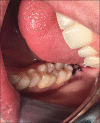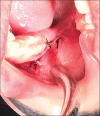Evaluation of two flap designs on the mandibular second molar after third molar extractions
- PMID: 28932049
- PMCID: PMC5596690
- DOI: 10.4103/jomfp.JOMFP_75_17
Evaluation of two flap designs on the mandibular second molar after third molar extractions
Abstract
Background: The extraction of third molars is associated with some clinical outcomes and periodontal problems. It is imperative to note that the type of incision used in the surgery for the removal of the impacted third molar is critical. The design of the flap influences the healing of the surgically created defect and damage to the distal periodontal area of the adjacent second molar. However, till date, there have been conflicting reports on the influence of different flap designs used for the surgical removal of impacted third molars.
Aim: The present study aimed to comparatively evaluate the clinical outcomes and periodontal status of the adjacent second molar, when two different flap designs, namely, the envelope and the modified triangular flap designs were used.
Materials and methods: Sixty female patients with bilateral impacted third molars completed the study with envelope flap on one side and modified triangular flap design on the other side of the mandible for third molar removal. Clinical parameters including pain, dehiscence and swelling were assessed postoperatively and periodontal probing depth (PPD) on the distal aspect of adjacent second molar were assessed both pre- and post-operatively.
Results: The results were assessed on 1, 3 and 8 days for pain using visual analog scale. The subjective perception of swelling was evaluated on 3, 7 and 15 days postoperatively in a similar manner. The results of the periodontal parameters were evaluated both preoperatively and 3 months postoperatively, with cautious exploration using a University of North Carolina (UNC)-15 periodontal probe. The statistically significant results for swelling and PPD were noted for the two flap groups using the Chi-square test (P < 0.05).
Conclusion: The study revealed that the modified triangular flap had lesser postoperative PPDs and dehiscence. The envelope flap was better when swelling was analyzed. The pain scores, though slightly higher for the modified triangular flap group, were not statistically significant.
Keywords: Envelope flap; flap design; impacted teeth; modified triangular flap; periodontal healing; third molar surgery.
Conflict of interest statement
There are no conflicts of interest.
Figures






References
-
- Chaparro-Avendaño AV, Pérez-García S, Valmaseda-Castellón E, Berini-Aytés L, Gay-Escoda C. Morbidity of third molar extraction in patients between 12 and 18 years of age. Med Oral Patol Oral Cir Bucal. 2005;10:422–31. - PubMed
-
- Motamedi MH. Concepts to consider during surgery to remove impacted third molars. Dent Today. 2007;26:136, 138–41. - PubMed
-
- Karaca I, Simşek S, Uğar D, Bozkaya S. Review of flap design influence on the health of the periodontium after mandibular third molar surgery. Oral Surg Oral Med Oral Pathol Oral Radiol Endod. 2007;104:18–23. - PubMed
-
- Monaco G, Daprile G, Tavernese L, Corinaldesi G, Marchetti C. Mandibular third molar removal in young patients: An evaluation of 2 different flap designs. J Oral Maxillofac Surg. 2009;67:15–21. - PubMed
-
- Koerner KR. The removal of impacted third molars. principles and procedures. Dent Clin North Am. 1994;38:255–78. - PubMed
LinkOut - more resources
Full Text Sources
Other Literature Sources

